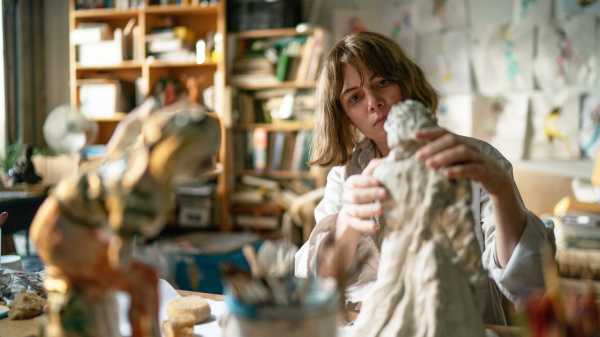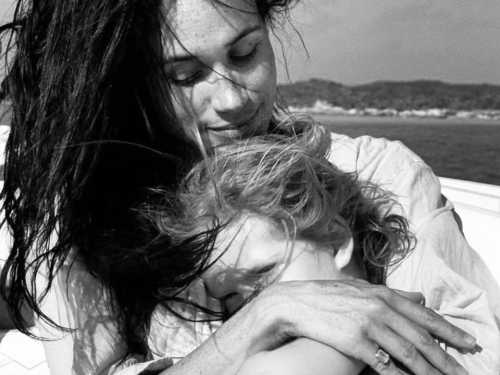
Until now, I haven’t been very enthusiastic about Kelly Reichardt’s films. While admiring her craft and determination, I’ve long felt that her movies mostly efface her characters’ inner lives in order to line up their events and emotions, like magnets, to form a simplified message. Her latest film, “Showing Up,” which opens Friday (it premièred at the Cannes Film Festival last May and had its U.S. début in October, at the New York Film Festival), is significantly different from her other films in its substance, mood, import, and approach. It’s a quiet, candid, sharply conceived and imaginatively realized masterwork, her first film of such bold and decisive originality; it’s Reichardt’s first great movie.
“Showing Up” is also the first of her films that includes a character whose persona is so closely related to Reichardt’s own position as a filmmaker. There’s no artistic mandate or necessity for filmmakers to mirror themselves or their experiences in their work, and doing so is no formula for making a good movie. What all great filmmakers have in common is a certain contact with the film, as with a sparkplug—it can be an idea, a style, or a method that yields the energizing spark. “Showing Up” depicts an experienced female artist at work, one who’s struggling to make and sustain a place in the professional realm of her art, and, here, Reichardt makes the ethical and economic concerns of her earlier work catch aesthetic fire.
And do they ever. The material of “Showing Up” feels like content under pressure, and the film bursts out with expansive creative energy that matches and redoubles the dramatic passion attached to its protagonist’s quests (and there’s more than one). It’s directed with a newly uninhibited audiovisual inventiveness, an image-to-image inspiration that makes this new film what most of her previous films weren’t: living experiences rather than script deliveries. In “Showing Up,” Reichardt seems to write the movie in images, directly onto the screen; its sense of subjectivity is, from the start, visual. The protagonist, Lizzy (Michelle Williams), is introduced at work, sculpting in clay, with a sculpture of hers in the foreground; it’s the film’s first post-credits image, and it plays, to me, like a primordial vision of the making of art as a devotion that’s equally physical and spiritual, and that fuses those aspects by way of style. Then, the camera pans slowly past a large array of Lizzy’s sculptures (small statues, mostly of women, in a variety of poses and dance-like positions) and, as the frame sweeps across the exquisite, quiet majesty of Lizzy’s work, it lands on a humble detail that proves important to the story: a partially opened, vertically sliding door that reveals her studio to be her garage.
The interweaving of expressive imagery, character development, and dramatic progress that’s on display in the movie’s first few minutes is exhilarating. “Showing Up” is a film that I’d like to be able to quote, not line by line but moment by moment, not least because its repertory of camera moves has the simultaneous feel of giddy adornments and narrative necessities. The creative joy that they express fuses Lizzy’s artistic drive with the sense that Reichardt herself is tapping into her own inner spring of deep feeling and aesthetic pleasure. For example, as Lizzy makes a stressful call to her father, Bill (Judd Hirsch), to invite him to the opening of her new show, she wanders onto the patio deck of her house, on the second floor, above the garage-studio, and gazes into the street. There, a woman named Jo (Hong Chau) takes a truck tire from the bed of her pickup, rolls it exuberantly in the street (the camera glides impulsively along with her) and up a narrow walkway into her back yard, where she hangs it on a tree to swing from, calling out to Lizzy, “Check it out.” But Lizzy doesn’t want to swing and doesn’t want to talk about swings: she wants Jo, who’s her friend and also her landlord, to fix her water heater so that she can take a shower.
But Jo is distracted—while Lizzy is rushing to finish her art in time for her opening eight days away, Jo is working equally hard to be ready for her two shows, both happening on Friday, in a mere five days. What’s more, Jo, who owns a small building in town, has a steady income from rents and doesn’t need a day job. Lizzy, with no other source of income, works full time in the office of a local art college—where her boss is her mother, Jean (Maryann Plunkett), and where the prestigious gallery space is one of the two venues where the illustrious Jo, the creator of brightly colored, large-scale, highly decorative, and brashly entertaining mixed-media installations, is having one of her two shows. (The other, an endowed exhibit, is considered a major honor, both for her and for the school, of which she’s an alumna.) Jo is as expansive and sociable as her art is brashly and playfully public-facing; Lizzy is as reserved, plainspoken, and tersely earnest as her art is calmly, adamantly, and candidly factual. The element of physical grace and understated tenderness that she puts into the work is also a secret element of her character, one that’s painfully overlooked by those who are closest to her, but that Reichardt’s camera detects and discloses.
The contrast emerges in a matched pair of scenes. One is in an older, warehouse-like building, where, in a sunlit studio space, Jo is working on a huge sculpture, involving big pieces of foam and long strands of strong wire, with an exertion of strength and big gestures, as rock music plays loudly on the radio. Then the film cuts to Lizzy, working on her modest yet emotionally powerful small statues in her quiet, silent, near-dark, music-free garage-studio. Jo tends to presumptuously rely on Lizzy, as if assuming that their time is equally unstructured, equally free. (There’s a karmic twist underlying the tension—a bird that’s injured by Lizzy’s cat becomes a flash point of shared responsibility that Lizzy unhappily but dutifully takes on.)
Meanwhile, Lizzy’s responsibilities are amplified by the proximity of her family. Bill, a potter, is retired, with a studio full of his unsold (or perhaps hoarded) work; she expresses surprise that he is content to putter around and watch TV, even as he behaves like a hip and seductively swaggering young artist at the center of the scene. Her parents are divorced, and they continue to backbite through Lizzy, yet she isn’t the focus of the family’s attention. Her brother, Sean (John Magaro), also an artist, is mentally ill; he lives alone in a house but can’t quite be trusted not to do himself harm or wander off obliviously. He’s struggling to live independently yet is painfully, unwillingly dependent; he gets tangled up in paranoid surmises and related outbursts of anger, his social skills are perched on the edge of petulance and rudeness, and he remains the apple of Jean’s eye as a wayward genius who still has a chance to shine, even as she diminishes and overlooks Lizzy’s actual achievements.
“Showing Up” is set in Portland, Oregon; the movie suggests, implicitly but clearly, that Lizzy lives there not because of her art or her job, but because it’s where her family—and, especially, her brother—lives. She’s a woman on the cusp of middle age who has taken on a large burden of family responsibility. As much as her duties weigh emotionally on her and make demands of her time, as much as they threaten her pursuit of art, she bears up under them without complaint, as the ethical and affective bedrock of her very being. As a result of her personal distractions involving family and Jo, she rushes to finish work in time for her show, against a clock that involves the firing of her work in the school’s kiln. (The kiln master is played, wryly and suavely, by André Benjamin, a.k.a. André 3000, whose flute playing is heard on the soundtrack.) Lizzy’s undue haste has a visible effect on the work that results.
Reichardt delights in the buzzing activity of the school, the students who are working hard to create their art, the teachers who devote the strength of their discernment to their students’ work, the wide variety of staff members whose daily exertions sustain the idealistic pursuits. Amid the teeming activity, Lizzy remains so opaque as to pass nearly unnoticed, so stolid and so stoic as to go largely unheard, so attentive and thoughtful as to be taken for granted. Williams brings an enormous, quiet depth of reflection and observation to Lizzy; sitting and eating lunch from a plastic container, she is nonetheless consumed with the vigor of thought and the weight of responsibility.
Lizzy is always on, working even when she appears not to be; art is always in the forefront of her consciousness, as when a tracking shot of skateboarders passing by her house lands on her coming across a streetside pile of trash, which she picks through in order to salvage materials for her work. The spiritual center of “Showing Up” is a scene in Lizzy’s studio, where she contemplates a small statue that has one arm missing and gets to work on it—removing the other arm and saying “sorry” before making the desired changes and additions. Reichardt shows the sculptor from behind, the back of her head in closeup, the camera approximating the artist’s viewpoint on her work. (As I watched this extended shot, I wondered whether it was Williams manipulating the sculpture or the real-life Portland sculptor Cynthia Lahti, whose work plays the role of Lizzy’s own.)
But this seemingly isolated scene of elated, fervent concentration is nonetheless tethered to the mesh of Lizzy’s personal connections, as stressful and as time-consuming as they may be. Her brusque and taciturn candor stands guard against the frustrations, the resentments, the toxic competitiveness that risk leaching into her art, that risk poisoning the one good and sure thing—and that risk rendering her few close relationships untenable. She embodies a classic dilemma in her effort to be, by her own lights, both a good artist and a good person, and the drama is centered on whether there’s a conflict, even a contradiction, between these two personal imperatives. It’s a hallmark of Reichardt’s exalted artistry that her approach to the crisis finds a resolution that’s as strongly visual as it is dramatic, that overcomes the contradiction by way of the essentially humanistic basis of Lizzy’s art, the first-person experience—of family, of friendship, of nature, of street life, of the cityscape—that it embodies and that she, in her creative representations, imbues with a grace of her own. It isn’t a stretch to liken the compositional sublimity of the movie’s dramatic climax to the celebrated ending of Antonioni’s “The Eclipse”; Reichardt delivers a cinematic urbanism of a similarly stunning power while overcoming, in her own way, its alienation.
There’s a special delight, as it relates to the critic’s daily activity, in the thrill of watching “Showing Up,” as well as a lesson (one that I learned long ago): never write off a director. A lay viewer who has little enthusiasm for a director’s work to date may not rush off to see that filmmaker’s new release. A critic, of course, is professionally obligated to do so, and my unreserved pleasure in Reichardt’s new film is heightened by the sense of seeing a veteran filmmaker in a new light, of the revelation of a familiar artist’s formerly untapped resources of art and aspects of character. If I’ve been frustrated by Reichardt’s earlier films, it’s because they’ve been made with such artistic dedication and purpose, with such care for substance and texture, that their distinctiveness bypasses the ordinariness of good movies and aims at greatness. Reichardt’s evident artistic self-liberation adds an extra joy to the viewing experience. ♦
Sourse: newyorker.com






